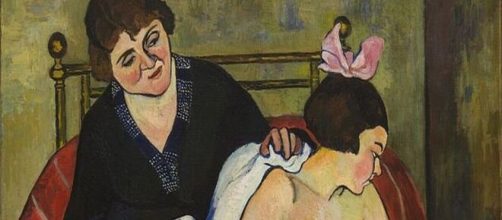From the onset of written history, mothering and the Arts have gone together like milk and cookies. Typifying the literary arts is Marcel Proust’s “Remembrance of Things Past,” which famously begins with a memory of waiting for his mother to kiss him goodnight.
Visual art on the same subject dates back before we knew how to write. The 25,000-year-old statue "Venus of Willendorf," an indisputable icon of maternity given its swollen belly and breasts, comes to mind.
New life
The Louisiana Museum of Modern Art, heralding a show called “Mother! Origin of Life” is a fitting way to give new life to exhibit halls long-shuttered during the pandemic.
And like art history itself, the show offers a wide variety of mothering images through the ages. Art Daily reports more than 140 works on display. Exhibit curator Marie Laurberg writes in the museum catalog, “The mother of art and culture has many faces.”
Laurberg is referring to the wide variety of faces in the show, ranging from a worshipful Madonna and Child to the hideous Medea, who murders her children. And even though the latter example conjures up Holden Caulfield famously saying in J.D Salinger’s "Catcher in the Rye," “Mothers are all slightly insane,” it’s all still milk and cookies, even if the snack is laced with poison.
Curatorial notes
The curator unconsciously illustrates Salinger’s point by pointing out several not-so-nice faces of motherhood in the show, such as the evil stepmother in Grimm’s fairy tales.
And she sums up the mother theme in art this way: “She is disappointed, dead, seductive or loving…She is an animal with breasts.”
Mother’s Day
But with Mother’s Day approaching, think over this exhibit example that may fit the Proust model. I’m thinking of contemporary painter Chantal Joffe’s Self-portrait Combing Esme’s Hair.
The title narrates the picture. Even so, what the artist show you – whether intended or not – looks to have more going on than combing a child’s hair. Esme is pictured as wide-eyed, almost as if afraid, and her mother is shown as an assured, all-knowing authority figure who comes across as controlling. This is an oddly self-incriminating picture since the mother painted it in the painting.
Joffe’s painting is reminiscent of another painting with a similar subject of a mother tending a child, and this one was made 100 years ago by Suzanne Valadon called "The Abandoned Doll." But unlike Joffe’s painting, the psychological drama here is plainly intentional, as indicated by the title. What you see is a woman toweling dry her clearly pre-pubescent daughter after a bath with a decidedly loving, even indulgent air. The daughter is turned away from her mother to peer into a hand mirror, suggesting a transition from childhood. A doll forgotten on the floor nails the point.
Real people
Valadon, best known as a model for the Impressionists, had no art training. Yet she bested the artists she posed for by portraying women as people, not motifs.


